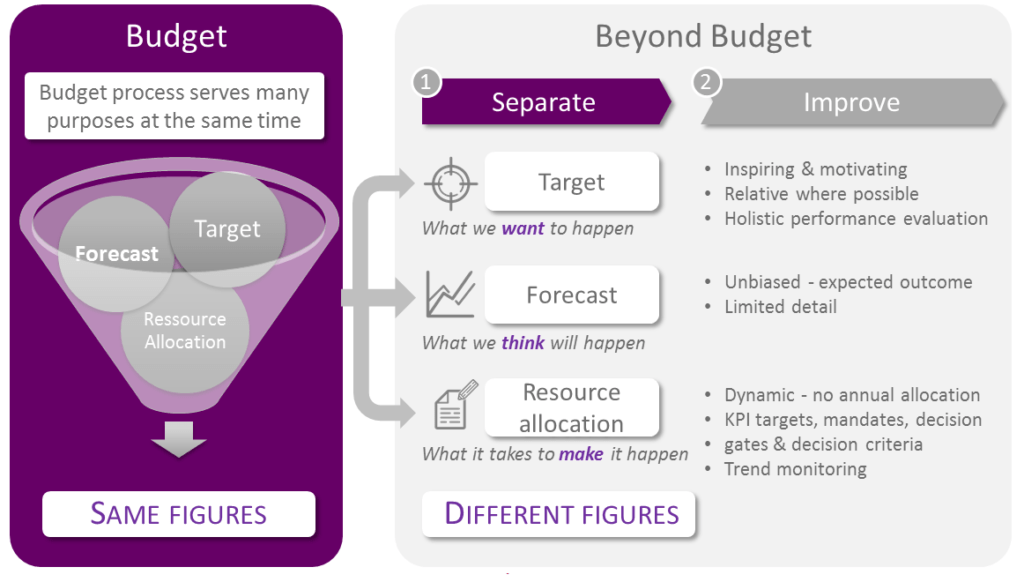The financial heart of big business beats in time with performance management cycles. All the more so as it also feeds into exchanges with their shareholders, shareholders’ representatives, analysts and so on, all concerned with the bottom line and the direction the business is taking.
The performance management cycle is based around five major objectives: adopting a long and medium-term strategic vision, identifying resource requirements and reallocation opportunities; implementing action plans capable of meeting business needs; defining the basis on which business performance and individual performance can be evaluated; and of course, providing the vital tools for clear communication with shareholders.
A key issue, engendering both inhibitory concerns and inspirational promises
There are many critics of the four-pronged Plan / Budget / Reporting / Revised Forecasting approach, which traditionally underpins performance management cycles, and they are often fairly scathing. Nevertheless, the undertaking and rolling-out of large-scale transformation projects remain rare.
Firstly, business performance management is certainly more than just a purely financial matter: it is at once intimately connected with the business environment, to which it must both respond and adapt on an ongoing basis, and also firmly anchored in the day-to-day running of the business, with implications for the entire management structure. Consequently, it has a huge impact on the business: setting targets and allocating bonuses, maintaining morale at all levels of the organization, maintaining quality data upon which to rely and the ability to plan ahead and take the right decisions at just the right moment.
If we then throw the word “transformation” into the mix, suddenly performance management change becomes a key issue, paradoxically a source of disquiet and also… big promises. The challenge in this kind of project is therefore twofold: to support the entire organization in the fundamental changes it has chosen and to turn these promises into a virtuous circle of which everyone can see the benefits. Moreover, these exercises often follow on from or occur within so-called VUCA periods [Volatility, Uncertainty, Complexity and Ambiguity] making it an even more risky change exercise.
A “soft revolution” rather than a “big bang”
Whilst transformation projects often make a “big bang”, in this instance such an approach is completely inappropriate: making changes across the board to all areas of the performance management model could be hugely damaging and would not facilitate the implementation of a virtuous circle along with the aforementioned concomitant benefits. Performance management change requires an entirely different approach. Two main drivers are required: a solidly-forged and ongoing link with the organization as a whole, and the ability to determine the key elements on which the new model might rely and the scheduling of their implementation.

BEYOND BUDGETING: or how to solve the budget conflicts to enable greater forward planning and agility in performance management?
With regard to the latter, two CAC40 companies, whilst implementing the Beyond Budgeting model [see graphic opposite] made radically different choices in how they elected to schedule their performance management change. Whilst leading tyre manufacturing group Michelin put its primary focus on the Balance Scorecard to free themselves of the budget in the second phase, food & nutrition product manufacturer Danone made its “farewell budget” the point of departure for the subsequent implementation of the various planks of its new performance management model. Such a choice is an even stronger signal given that it marks the entry of the company into a new mode of performance handling, impacting not only the Finance community but the whole organization from the General Managers to the Operations, Marketing, Sales and Human Resources teams.
Make everyone an ambassador for the model
This is where the organization’s support for the introduction of this new management model comes into its own. Although the launch of each new process in the management cycle should be accompanied by the dissemination of the appropriate documentation and training for the affected groups, along with management training, the key to the success of this “soft revolution” lies elsewhere. What is required is an assessment of the uptake of the new model by increasing the transfer of data upstream (via surveys or interviews), by monitoring deployment progress and by intervening when necessary to clear any obstacles at COMEX level. This ongoing dialogue between the project and the organization should also be supported by the setting up of communities (whether via the intranet, Facebook@work, etc) which allow best practices and success stories to be shared; in other words, to capture and share the benefits of the virtuous circle, and make everyone an agent of and an ambassador for the model.
The immutability of the management model, and the belief that any changes to it are utopian or too risky, are therefore erroneous observations, and ones which are too readily accepted as evidenced by the paucity of large scale projects. The experience of the big companies involved in this kind of transformation ultimately prove the rule which might serve as a leitmotif: “never give up”. Challenging yourself. Reinventing yourself.


